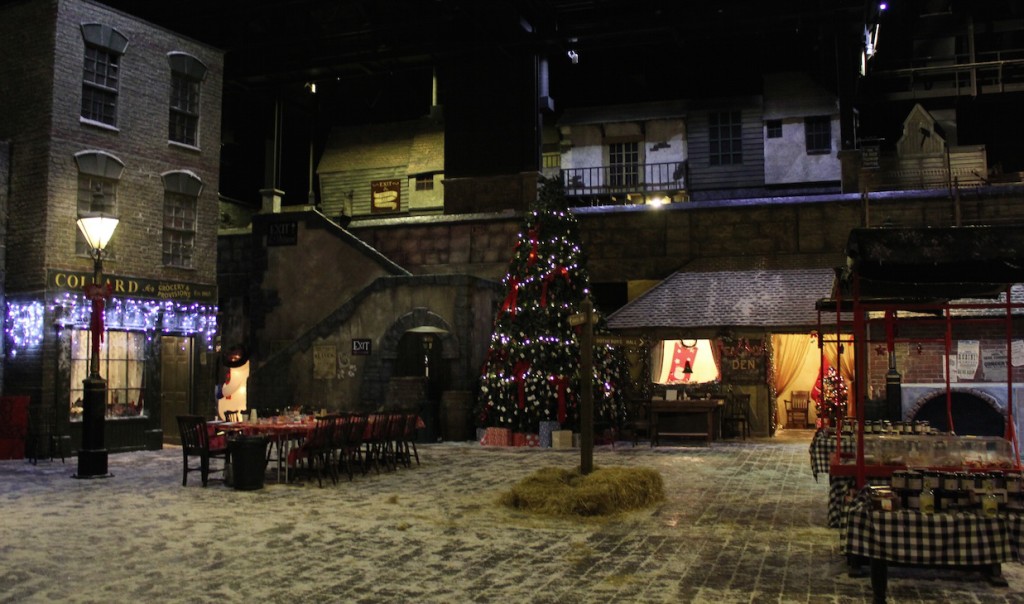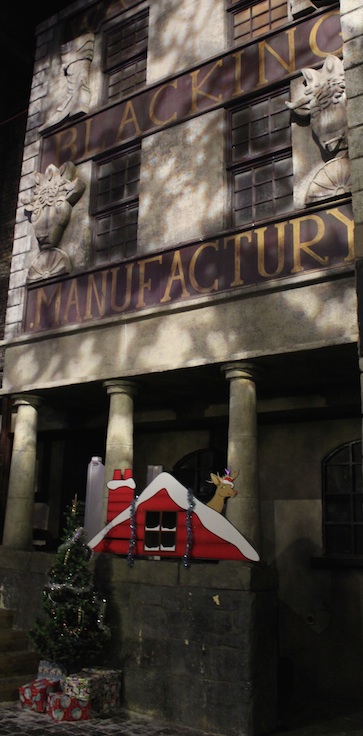After Dickens World
A few years ago I reviewed Juliet John’s Dickens and Mass Culture (2010). In her last chapter John discusses Dickens World, a Dickens-themed attraction located in Chatham, about an hour outside of London, where Dickens spent part of his childhood. I’ve wanted to visit ever since I learned such a place existed, and lately even more so: much of the initial media coverage accused Dickens World of “Disneyfying” Dickens, an accusation relevant to my current research about Disney and the Victorians (and Dickens and Disney). So when I traveled to London with my wife and in-laws, I talked them into going.
I’m working on a more formal article about Dickens World, but here I’ll just describe what Dickens World used to be and my own somewhat surreal experience visiting Dickens World in its post-bankruptcy, redefined form.
What Was Dickens World?

A history of Dickens World could be written through journalists’ puns and allusions. In 2007 a writer for the Toronto Star had “great expectations” for the site (though the BBC printed that allusion with a question mark).
When it opened, Dickens World was essentially a small theme park (though they carefully avoided that phrase). It was — and still is — located in the Chatham docks, in what is essentially a warehouse. Guests would guide themselves through several Dickens-themed attractions. These included:
- A Great Expectations-themed boat ride through a Victorian sewer (York Memberly reports being warned of “brown fish”), billed as the highlight of the attraction;
- A “haunted house,” initially advertised as Scrooge’s but changed, before opening, to “the haunted house of 1859”;
- A 4D biographical movie at Peggotty’s boathouse;
- Dotheboys Schoolhouse, featuring a test on Dickens’s life and works and an actor playing a scolding schoolmaster;
- “Fagin’s den,” a “McDonald’s-style playground” with (as Marty Gould and Rebecca Mitchell point out) a “wildly inappropriate title” (“Worst of Times” 292);
- A restaurant, The Six Jolly Fellowship Porters;
- And a gift shop, the (deliberately?) misspelled Olde Curiosity Shoppe.
In 2012 Dickens World made Time‘s list of the ten weirdest theme parks, and by 2013 nobody referred to “great expectations,” even with a question mark. Reporters instead pointed out Hard Times for Dickens World. Somehow a boat trip through a sewer and being yelled at by a Victorian schoolteacher weren’t as popular as originally envisioned.
Dickens World Today
Dickens World Ltd., the company that operates the site, went bankrupt in 2013. Since then, the attractions I listed above have been replaced with “an interactive guided tour experience that takes visitors back in time to Victorian/Dickensian England.” The boat ride is completely gone, though the remnants of some of the other attractions are still there. The website bills the tour as “a fun and educational experience for all ages,” but it hasn’t been that successful. As Lam Thuy Vo puts it, “Few people, it seems, want to experience poverty through a theme park”.
Perhaps as a response to the low tourist turnout, in December Dickens World was transformed into Santa’s village. The gimmick is that child visitors are helping Santa get ready for Christmas: elves let visitors color in pictures, play a carnival game, and visit Santa. (Dickens is notably absent from all those experiences, despite the myriad opportunities for a Dickensian Christmas attraction).

We visited a couple days after Christmas, when the “help Santa’s elves get ready” theme made even less sense. Fong, Gould, and Mitchell describe entering Dickens World on the second floor, over a rickety suspension bridge — that’s been done away with, and we entered through the gift shop on the first floor. The elves were upbeat and initially committed to the theme — despite the fact that my wife Kate, my mother in law, and I were the only ones there. We politely declined the coloring books, and wandered somewhat aimlessly through the Dickensian facades until one of actors very kindly agreed to put aside his elf costume and instead take us on the non-seasonal tour. We were grateful.

The tour consists of a walk through Camden Town, where our guide explained how many families would live in one room; Marshalsea prison, with a similar focus on cramped spaces and general Victorian bleakness; the haunted house, where he showed off the “Pepper’s Ghost” trick; and Dotheboys schoolhouse, where he donned a black cloak and played the roll of domineering schoolmaster (I got to write write lines on a chalkboard). If the usual tour is 90 minutes, ours was somewhat abbreviated.
Kate best characterized our overall experience at Dickens World: like being on Disney’s Pirates of the Caribbean, when it breaks down and the lights come on. The spectacle is still there, but the enchantment is gone.
John ends Dickens and Mass Culture by pondering the future:
The success or failure of Dickens World, both economically and culturally, will tell us a great deal about whether or not Dickens’s inclusive vision for the amusements of the people remains viable in the twenty-first century, and about the extent to which Dickens still amuses the people. (289)
It’s a fairly safe bet that the legacy of Dickens World will be “failure” rather than “success” — whether that means Dickens no longer amuses the people is perhaps another question (and one I’ll be thinking about as I think about Dickens World in more scholarly ways). But there has been an upside: besides John, several other very smart Victorianists have written about Dickens World, including Ryan Fong, Alison Booth, Marty Gould, Rebecca Mitchell, Alexis Easley and Kathryn Hughes. All wrote before 2013, when the site went bankrupt, but even at its peak, Dickens World didn’t seem destined for success (it opened in 2007, right before the global recession).
Dickens World’s failure, though, doesn’t spell the end of the literary theme park. I live in Orlando, where in July 2014 Universal Studios opened an expansion of its Wizarding World of Harry Potter. Based on the opening, the chances slim that it will close down all the rides and become a 90-minute tour of Diagon Alley.
Works Cited and Further Reading
Anderson, Sam. “The World of Charles Dickens, Complete with Pizza Hut.” The New York Times, February 7th 2012.
Booth, Alison. “Time Travel in Dickens’ World.” Literary Tourism and Nineteenth-Century Culture. Nicola J. Watson, ed. Palgrave, 2009.
Easley, Alexis. Literary Celebrity, Gender, and Victorian Authorship, 1850-1914. University of Delaware, 2011.
Fong, Ryan. “Uncommercial Travels in Dullborough Town, or My Journey to Dickens World and Dickens’s World.” Dickens Universe, 2012. (Ryan generously shared the manuscript of his talk)
Glavin, John. After Dickens: Reading, Adaptation, and Performance. Cambridge University Press, 1999.
Gould, Marty and Rebecca N. Mitchell. “It Was the Worst of Times: A Visit to Dickens World.” Victorian Literature and Culture 38 (2010), 287-318.
Gould, Marty and Rebecca N. Mitchell. “Understanding the Literary Theme Park: Dickens World as Adaptation.” Neo-Victorian Studies 3.2 (2010), pages 145-171.
Hughes, Kathryn. “Dickens World and Dickens’s World.” Journal of Victorian Culture 15.3 (December 2010), 388-393.
Huntley, Dana. “Visiting in Dickens World.” British Heritage 29.4 (Sep. 2008), pp. 42-5.
John, Juliet. Dickens and Mass Culture. Oxford University Press, 2010.
Memberly, York. “Great expectations for newly opened Dickens World.” Toronto Star February 3, 2008.
Price, Chris. “Hard Times for Dickens World investors after Dickens World Ltd.” Kent Online October 10, 2013.
Vo, Lam Thuy. “Launched to great expectations, Dickens theme park falls on hard times.” Al Jazeera America December 16, 2014.